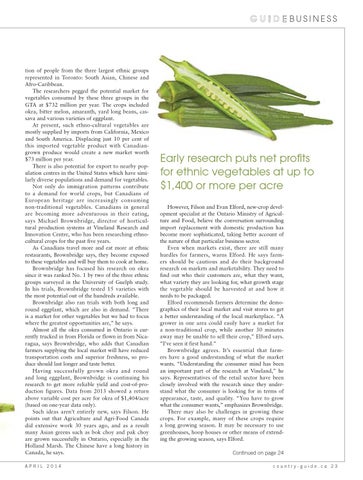business
tion of people from the three largest ethnic groups represented in Toronto: South Asian, Chinese and Afro-Caribbean. The researchers pegged the potential market for vegetables consumed by these three groups in the GTA at $732 million per year. The crops included okra, bitter melon, amaranth, yard long beans, cassava and various varieties of eggplant. At present, such ethno-cultural vegetables are mostly supplied by imports from California, Mexico and South America. Displacing just 10 per cent of this imported vegetable product with Canadiangrown produce would create a new market worth $73 million per year. There is also potential for export to nearby population centres in the United States which have similarly diverse populations and demand for vegetables. Not only do immigration patterns contribute to a demand for world crops, but Canadians of European heritage are increasingly consuming non-traditional vegetables. Canadians in general are becoming more adventurous in their eating, says Michael Brownbridge, director of horticultural production systems at Vineland Research and Innovation Centre, who has been researching ethnocultural crops for the past five years. As Canadians travel more and eat more at ethnic restaurants, Brownbridge says, they become exposed to these vegetables and will buy them to cook at home. Brownbridge has focused his research on okra since it was ranked No. 1 by two of the three ethnic groups surveyed in the University of Guelph study. In his trials, Brownbridge tested 15 varieties with the most potential out of the hundreds available. Brownbridge also ran trials with both long and round eggplant, which are also in demand. “There is a market for other vegetables but we had to focus where the greatest opportunities are,” he says. Almost all the okra consumed in Ontario is currently trucked in from Florida or flown in from Nicaragua, says Brownbridge, who adds that Canadian farmers supplying the local market will have reduced transportation costs and superior freshness, so produce should last longer and taste better. Having successfully grown okra and round and long eggplant, Brownbridge is continuing his research to get more reliable yield and cost-of-production figures. Data from 2013 showed a return above variable cost per acre for okra of $1,404/acre (based on one-year data only). Such ideas aren’t entirely new, says Filson. He points out that Agriculture and Agri-Food Canada did extensive work 30 years ago, and as a result many Asian greens such as bok choy and pak choy are grown successfully in Ontario, especially in the Holland Marsh. The Chinese have a long history in Canada, he says. April 2014
Early research puts net profits for ethnic vegetables at up to $1,400 or more per acre However, Filson and Evan Elford, new-crop development specialist at the Ontario Ministry of Agriculture and Food, believe the conversation surrounding import replacement with domestic production has become more sophisticated, taking better account of the nature of that particular business sector. Even when markets exist, there are still many hurdles for farmers, warns Elford. He says farmers should be cautious and do their background research on markets and marketability. They need to find out who their customers are, what they want, what variety they are looking for, what growth stage the vegetable should be harvested at and how it needs to be packaged. Elford recommends farmers determine the demographics of their local market and visit stores to get a better understanding of the local marketplace. “A grower in one area could easily have a market for a non-traditional crop, while another 30 minutes away may be unable to sell their crop,” Elford says. “I’ve seen it first hand.” Brownbridge agrees. It’s essential that farmers have a good understanding of what the market wants. “Understanding the consumer mind has been an important part of the research at Vineland,” he says. Representatives of the retail sector have been closely involved with the research since they understand what the consumer is looking for in terms of appearance, taste, and quality. “You have to grow what the consumer wants,” emphasizes Brownbridge. There may also be challenges in growing these crops. For example, many of these crops require a long growing season. It may be necessary to use greenhouses, hoop houses or other means of extending the growing season, says Elford. Continued on page 24 country-guide.ca 23
